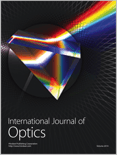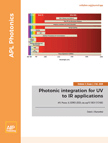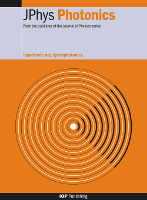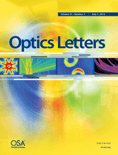
Biomedical Optics Express
metrics 2024
Advancing Knowledge Through Optical Technologies
Introduction
Biomedical Optics Express, published by the prestigious Optica Publishing Group, is an open-access journal that has been at the forefront of the field of biomedical optics since its inception in 2011. With an ISSN of 2156-7085, this journal has established itself as a premier platform for disseminating high-quality research that spans an array of topics in atomic and molecular physics, optics, and biotechnology. As a testament to its scholarly impact, it is currently ranked in the Q1 category for both Atomic and Molecular Physics and Biotechnology, reflecting its commitment to excellence within these disciplines. The journal features cutting-edge articles that foster innovation and collaboration among researchers, professionals, and students who are passionate about applying optical technologies to solve pressing challenges in medicine and biology. Based in the United States, Biomedical Optics Express continues to shape the future of optical science and its applications, inviting contributions that inspire and drive forward the boundaries of knowledge.
Metrics 2024
 0.93
0.93 2.90
2.90 3.20
3.20 108
108Metrics History
Rank 2024
Scopus
IF (Web Of Science)
JCI (Web Of Science)
Quartile History
Similar Journals

Journal of Biophotonics
Advancing Research at the Intersection of Light and LifeJournal of Biophotonics is a prestigious academic journal published by WILEY-V C H VERLAG GMBH in Germany, dedicated to advancing the field of biophotonics through high-quality research. With an ISSN of 1864-063X and an E-ISSN of 1864-0648, this journal is recognized for its contributions within diverse categories, including biochemistry, genetics, molecular biology, chemistry, engineering, materials science, and physics, earning a commendable Q2 ranking in several of these fields as of 2023. The journal aims to bridge the gap between theoretical research and practical applications, fostering interdisciplinary collaboration that is critical for innovations in imaging, diagnostics, and therapeutics. Researchers, professionals, and students alike will find the Journal of Biophotonics invaluable for staying informed about the latest developments and breakthroughs in this dynamic field, making it a cornerstone for knowledge dissemination and scholarly discourse from its inception in 2008 and continuing through 2024.

International Journal of Optics
Connecting Science and Application in OpticsWelcome to the International Journal of Optics, a distinguished publication dedicated to advancing the field of optics and its interdisciplinary applications. Published by HINDAWI LTD, this open-access journal has been pivotal in fostering knowledge since its inception in 2009. With a robust focus on atomic and molecular physics as well as electronic, optical, and magnetic materials, the journal has carved its niche within Q3 quartile rankings in these categories for 2023, signifying its growing impact and relevance in the scientific community. Researchers and professionals will find a rich repository of innovative and cutting-edge research articles that not only address fundamental aspects of optics but also explore practical applications across various domains. The journal's aim is to promote high-quality research dissemination, enhancing collaboration among scientists and ensuring that pivotal findings reach a global audience. Join us in exploring the dynamic world of optics—where your contributions help shape the future of science.

APL Photonics
Transforming Ideas into Photonic BreakthroughsAPL Photonics is a premier open-access journal published by AIP Publishing, dedicated to the field of photonics, encompassing a broad range of research areas including atomic and molecular physics, optics, and computer networks and communications. Since its inception in 2016, the journal has positioned itself at the forefront of innovation, earning Q1 quartile rankings in both relevant categories as of 2023. With an impressive Scopus ranking that places it in the 87th and 89th percentiles for its respective fields, APL Photonics serves as a vital platform for rapid dissemination of high-impact research. Its open-access policy ensures that cutting-edge findings are accessible to researchers, professionals, and students globally, facilitating collaboration and knowledge sharing. Aimed at fostering advancements in the photonics community, this journal is essential for those looking to stay informed on the latest breakthroughs and trends in photonic technologies.

OPTICAL REVIEW
Fostering Global Collaboration in Optical SciencesOPTICAL REVIEW is a distinguished journal published by the Optical Society of Japan that serves as a critical platform for researchers, professionals, and students within the diverse fields of atomic and molecular physics and optics. With its ISSN 1340-6000 and E-ISSN 1349-9432, the journal has had a significant impact on the dissemination of knowledge since its inception in 1994, with a planned coverage until 2024. Although it currently holds a Q4 ranking in the 2023 category quartiles and is positioned at rank #152 out of 224 in the Scopus database, its contributions are vital for advancing optical science. This journal provides a venue for innovative research, review articles, and significant developments that drive the optical sciences forward. Although not categorized as Open Access, it remains an important resource for those seeking to deepen their knowledge and engage with leading-edge research in optics. With its base located at the Kudan-Kita Building in the heart of Tokyo, Germany, OPTICAL REVIEW is poised to continue fostering scholarly communication and collaboration on a global scale.

JOURNAL OF MODERN OPTICS
Empowering Researchers in the Realm of LightJOURNAL OF MODERN OPTICS, published by Taylor & Francis Ltd, stands as a prominent bi-monthly journal contributing to the fields of Atomic and Molecular Physics and Optics. With an ISSN of 0950-0340 and an E-ISSN of 1362-3044, this journal aims to disseminate high-quality research that pushes the boundaries of optical science and its applications. Since its inception in 1981, and particularly throughout its publications from 1987 to 2024, the journal has consistently published influential studies that are essential for both academic researchers and industry professionals. Ranked in the Q3 quartile for the 2023 category of Atomic and Molecular Physics and Optics, it has a Scopus ranking of #133 out of 224, indicating its steady presence and relevance in the scientific community. Although it does not offer Open Access options, readers can access its rich repository of literature that delves into innovative optical methods, technological advancements, and theoretical frameworks. The JOURNAL OF MODERN OPTICS is an indispensable resource for those seeking to advance their knowledge and research in modern optical science.

Journal of Physics-Photonics
Exploring the Spectrum of Photonic TechnologiesJournal of Physics-Photonics, published by IOP Publishing Ltd in the United Kingdom, is an esteemed Open Access journal that has been at the forefront of research in the field of photonics since its inception in 2018. With an impressive portfolio, the journal has achieved Q1 ranking in 2023 across multiple disciplines, including Atomic and Molecular Physics, Electrical and Electronic Engineering, and Electronic, Optical, and Magnetic Materials. This positions it among the leading journals in these areas, reflecting its significant influence and contribution to advancing knowledge and innovation. The journal aims to disseminate high-quality research findings that encompass a wide range of topics in photonics, promoting interdisciplinary approach that fosters collaboration among researchers, professionals, and students. With its commitment to open access, Journal of Physics-Photonics ensures that groundbreaking research is accessible to all, empowering a global audience to engage with and benefit from the latest advancements in photonic technologies.

Korean Journal of Optics and Photonics
Shaping Tomorrow's Technologies with LightKorean Journal of Optics and Photonics is a premier publication dedicated to advancing knowledge in the rapidly evolving fields of optics and photonics. Published by the esteemed Optical Society of Korea, this journal serves as a vital platform for researchers, professionals, and students seeking to disseminate their findings and innovations in areas such as optical engineering, photonics technologies, and application developments. Although the journal does not operate under an Open Access model, it is committed to high-quality peer-reviewed research that contributes significantly to both theoretical and practical advancements in the field. With an increasing focus on interdisciplinary research, the Korean Journal of Optics and Photonics is poised to play a crucial role in fostering collaboration and driving the global conversation on light science and technology. The journal's ISSN is 1225-6285 and it also carries the E-ISSN 2287-321X, ensuring its availability to a wide readership.

Journal of Innovative Optical Health Sciences
Transforming Patient Care Through Optical ScienceWelcome to the Journal of Innovative Optical Health Sciences, an esteemed platform dedicated to the interdisciplinary exploration of optical technologies in health sciences. Published by World Scientific Publishing Co Pte Ltd, this open-access journal has been at the forefront of innovation since its inception in 2008, facilitating vital discussions and research advancements. With a notable impact factor and a commendable ranking in various scientific categories—including Q2 in Atomic and Molecular Physics, Q3 in Biomedical Engineering, and Q3 in Medicine (miscellaneous)—the journal serves as an essential resource for researchers, professionals, and students alike. Hailing from Singapore, we aim to bridge the gap between optical science and healthcare, promoting breakthroughs that enhance patient care and medical practices. Explore our diverse collection of studies and join a vibrant community committed to advancing knowledge in this cutting-edge field.

Current Optics and Photonics
Empowering Researchers in Optics and PhotonicsCurrent Optics and Photonics is a premier journal published by the Optical Society Korea, focusing on the dynamic and evolving fields of optics and photonics. With an ISSN of 2508-7266 and E-ISSN 2508-7274, it provides a comprehensive platform for scholarly communication, emphasizing innovations, advances in technology, and theoretical developments in atomic and molecular physics and optics. Situated in South Korea's vibrant academic landscape, this open access journal aims to bridge the gap between theoretical research and practical applications, fostering collaboration and knowledge sharing among researchers, professionals, and students alike. Although currently ranked in the Q3 category for both Atomic and Molecular Physics and Optics, with a Scopus rank of #183/224, it showcases significant contributions that enhance understanding in these critical areas. The journal encourages submission of original research articles, reviews, and technical notes, with the objective of driving forward the conversation in optics and photonics throughout its converged years from 2017 to 2024. Embrace the opportunity to contribute to this expanding field and become part of a community that is at the forefront of scientific discovery.

OPTICS LETTERS
Pioneering Innovations in Optical ScienceOPTICS LETTERS is a premier academic journal published by the Optica Publishing Group, dedicated to advancing the field of optics and photonics. Since its inception in 1977, it has maintained a strong reputation for publishing high-impact research, holding a distinguished Q1 category ranking in Atomic and Molecular Physics, as well as Optics, making it a vital resource for researchers and professionals alike. With an impressive Scopus rank of #55 out of 224 in its field, OPTICS LETTERS continues to shape the discourse and innovation in optical science. Authors benefit from its extensive international reach, while readers gain access to cutting-edge studies that address both theoretical and applied aspects of optics. Although the journal currently does not offer open access options, its rigorous peer-review standards ensure that every publication meets the highest academic criteria, making it an essential journal for anyone looking to stay at the forefront of optical research.